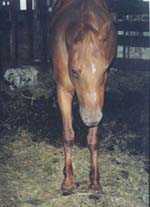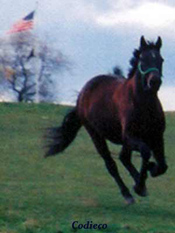
Legislation Information
Pending Legislation
PA's Electronic Bill Room
Type in the word "equine" in the search box to locate bills, (proposed legislation) relating to horses.
Federal Laws
Proposed regs will legalize every inhumane practice identified in the transport of horses to slaughter!
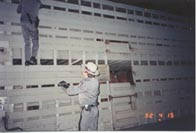
Doubles will be legal for 5 years AFTER the proposed regs go into effect. It has already been 4 1/2 years, that makes for 10 years of the continued use of doubles after this legislation passed..
EPN's Comments
on Proposed Regulations For the 1996 Commercial Transportation of Horses To Slaughter Act
CA Equine Council's
Comments on the Proposed Regulations For the 1996 Commercial Transportation of Horses To Slaughter Act
State Laws
Proposition 6,
The PROHIBITION of Horse Slaughter and Sale of Horsemeat for Human Consumption Act Of 1998, Does Not Violate The Commerce Clause
Horsemeat Laws
1996 Commercial Transportation Of Horses To Slaughter Act
December 7, 2001
Final Rule Commercial Transportation of Horses to Slaughter Act
American Horse Council, American Horse Protection Association, & Humane Society of US
propose to legalize every inhumane practice identified in the transport of horses to slaughter & put the very people identified as the abusers, the "killer buyers" in charge of the horses!
Proposed Regulations For the 1996 Commercial Transportation of Horses To Slaughter Act
USDA Animal & Plant Health Inspection Service, APHIS
Approval of Livestock Facilities;
Interstate Movement of EIA Reactors
USDA Food Safety Inspection Service, FSIS, Regulations
Biological Residues in Horses;
Slaughter of Foaling Mares;
Slaughter of Sick Horses;
USDA APHIS Humane Slaughter Act

AZ Transport Law
CA Transport Law
CT Transport Law
MA Transport Law
MN Transport Law
NY Transport Law
Ag and Markets, Section 359-a
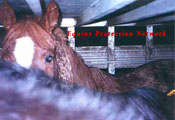
Horses inside double deck cattle trailer stopped by the NYSP. The owner was later convicted & fined $3000.00.
VA Transport Law
Vermont Transport Law
PA Anti Cruelty Law
Title 18, Section 5511
Sign Posted at PA Horse Auctions is NOT the Law!
Sign outside auctions is incorrect!

Sign posted outside 2 PA horse auctions regarding the PA Anti Cruelty Statute is incorrect! " Maybe the posting of this sign has something to do with "the agreement" that the auctions and the PA SPCA have with each other...
U.S. Anti-Cruelty Statutes
PA Domestic Animal Act
Licensing of Dealers & Haulers
EIA Regulations, Coggins Test
PA Dead Animal Act
Requirements for Removal of Dead Animals
PA Animal Markets
General Provisions
Records
Transactions From Trucks
IL Horsemeat Act
Texas Law
Sale of Horsemeat for Human Consumption
Prohibits Sale of Horsemeat For Human Consumption
Texas Attorney General Cornyn States TX Law
Prohibiting Sale of Horsemeat Applies to the 2 Texas Horse Slaughterhouses!
Links
California Voters "Just Say Neigh" to Horse Slaughter!
HoofPAC
Shop online at IGive.com with over 600 great stores you know & love- including Back In the Saddle! Up to 26% of the purchase price is donated to the EPN!
The EPN gets $5 extra the first time you shop!
PayPal accepts credit cards! Please send your tax deductible donation to the:Equine Protection Network, Inc.,
P. O. Box 232, Friedensburg, PA, 17933.
Shop for CD's at CDRush.com & the EPN Benefits!
Put "EPN" in the Coupon Code box when you place your order.
Now you can save money on your favorite music and help the horses at the same time!
HoofPAC is the political action committee that has been formed to end the slaughter of America's horses. Cathleen Doyle, founder of HoofPAC, led the successful Save The Horses campaign in 1998 that made the slaughter of California's horses a felony.

Food Safety Inspection Service, FSIS Regulations
Federal Food, Drugs, & Cosmetic Act
Warning Letters Issued by Food & Drug Administration, FDA
Frank Carper Warning Letter
Involving 3 horses sold for slaughter in 2000This letter indicates Mr. Carper's failure to take action to correct the problem. In a separate and unrelated incident Mr.Carper has failed to pay his fine to Essex County, NY for violating NY's Horse Transport Law. Horse Popsicle Case Yet PA Department of Agriculture continues to license Mr. Carper.The letter also discusses Mr. Carper's record keeping practices.
PART 556_TOLERANCES FOR RESIDUES OF NEW ANIMAL DRUGS IN FOOD
I.W. Ward
This letter deals with a horse sold to Bel-Tex that had Streptomyocin drug residues in the kidneys. The letter also discusses Mr. Ward's record keeping practices.The EPN believes that the Internal Revenue Service needs to take a hard look at horse dealers. Obviously the individual state departement of agricultures have failed miserably to enforce their regulations regarding the licensing of horse dealers/transporters that require dealers to maintain records. These regualtions are put on the books for trace back purposes in case of disease outbreak.
How Safe is Horsemeat? - HoofPAC
Code of Federal Regulations, CFR, Online
TITLE 9--ANIMALS AND ANIMAL PRODUCTS
CHAPTER II
FOOD SAFETY AND INSPECTION SERVICE, MEAT AND POULTRY INSPECTION, DEPARTMENT OF AGRICULTURE
PART 309--ANTE-MORTEM INSPECTION
This page will highlight certain sections of the FSIS regulations that the EPN believes are ignored in the slaughter of horses.
Scenario
- A racehorse has suffered a leg injury at a PA racetrack on Thursday.
- The horse is head bobbing lame at the walk.
- The horse is pointing the affected leg when at rest.
- The horse does bear some weight on the affected leg.
- The owner decides to ship the horse to the sale on Monday.
- The horse is purchased by a "killer buyer" who transports horses to Texas for slaughter for human consumption.
- The trip to Texas takes 28 hours.
- The truck departs Tuesday for Texas.
- The horse is killed Wednesday or Thursday, 7 to 8 days after the original injury.
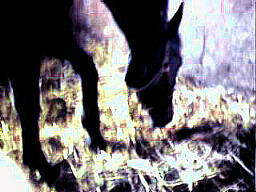

Lovely TB racehorse sold at a PA horse auction.
Loaded onto a double decker cattle trailer and shipped to TX.
The researcher at the sale later stated that the horse did not fare well and had,
"worn holes into his side from leaning against the portholes of the trailer.
Your tax dollars supported this horse being shipped to TX, as he was part of a USDA study for the Commercial Transportation of Horses to Slaughter Act of 1996.
Questions
If the answers to the above questions are yes, then the
PA Anti-Cruelty Law
is being violated on a regular basis at PA horse auctions.
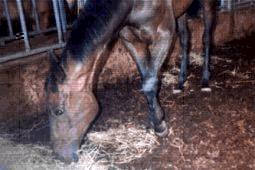
TB sold at a PA horse auction. An equine vet shown the picture of this horse's leg speculated that the horse had suffered a breakdown injury, including fracture(s) of the sesamoids. In other words, a broken leg. A humane agent at the sale asked,
"What are 'sesamoids'?"
The EPN strongly believes that the above scenario, which happens on a regular basis at PA horse auctions and at other auctions throughout the United States is illegal. It violates anti-cruelty statutes and FSIS regulations. The practice is a black eye for the horse industry.
A better description for it is "Blood Money"Section
- 309.1 Ante-mortem inspection in pens of official establishments.
- 309.2 Livestock suspected of being diseased or affected with certain conditions; identifying suspects; disposition on post-mortem inspection or otherwise.
- 309.3 Dead, dying, disabled, or diseased and similar livestock.
- 309.4 Livestock showing symptoms of certain metabolic, toxic, nervous, or circulatory disturbances, nutritional imbalances, or infectious or parasitic diseases.
- 309.6 Epithelioma of the eye.
- 309.7 Livestock affected with anthrax; cleaning and disinfection of infected livestock pens and driveways.
- 309.10 Onset of parturition.
- 309.11 Vaccine livestock.
- 309.12 Emergency slaughter; inspection prior to.
- 309.13 Disposition of condemned livestock.
- 309.15 Vesicular diseases.
- 309.16 Livestock suspected of having biological residues.
- 309.17 Livestock used for research.
- 309.18 Official marks and devices for purposes of ante-mortem inspection.
- 311.26 Emaciation
- 311.39 Biological residues.
Read the labels on the items of the products you use on your horses or that are marketed for use on horses. Many of these products state,
"Not for use on horses intended for food."
Drug companies and comapnies that manufacture items for use on horses do not test these drugs for biological residues in horses. The testing is time consuming and expensive. The Food and Drug Administration, FDA, has stringent requirements that must be met. A drug withdrawal time must be determined.
Why is this testing not done with horses as it is with cattle, sheep and hogs?
Because horses are not a food animal in the United States.
We don't raise horses for food or fiber.
Americans do not eat horses.
There is no demand in America for horsemeat.
PART 309--ANTE-MORTEM INSPECTION--Table of Contents
Sec. 309.16 Livestock suspected of having biological residues.
(a) Except as provided by paragraph (d) of this section, livestock suspected of having been treated with or exposed to any substance that may impart a biological residue which would make the edible tissues unfit for human food or otherwise adulterated shall be handled in compliance with the provisions of this paragraph. They shall be identified at official establishments as ``U.S. Condemned.'' These livestock may be held under the custody of a Program employee, or other official designated by the Administrator, until metabolic processes have reduced the residue sufficiently to make the tissues fit for human food and otherwise not adulterated. When the required time has elapsed, the livestock, if returned for slaughter, must be re-examined on ante-mortem inspection. To aid in determining the amount of residue present in the tissues, officials of the Program may permit the slaughter of any such livestock for the purpose of collecting tissues for analysis for the residue. Such analysis may include the use of inplant screening procedures designed to detect the presence of antimicrobial residues in any species of livestock.
(b) All carcasses and edible organs and other parts thereof, in which are found any biological residues which render such articles adulterated, shall be marked as ``U.S. Condemned'' and disposed of in accordance with Sec. 314.1 or Sec. 314.3 of this chapter.
CHAPTER III--FOOD SAFETY AND INSPECTION SERVICE, DEPARTMENT OF AGRICULTURE
PART 311--DISPOSAL OF DISEASED OR OTHERWISE ADULTERATED CARCASSES AND PARTS--Table of Contents
Sec. 311.39 Biological residues.
Carcasses, organs, or other parts of carcasses of livestock shall be condemned if it is determined that they are adulterated because of the presence of any biological residues.
PART 309--ANTE-MORTEM INSPECTION--Table of Contents
Sec. 309.2 Livestock suspected of being diseased or affected with certain conditions; identifying suspects; disposition on post-mortem inspection or otherwise.
(a) Any livestock which, on ante-mortem inspection, do not clearly show, but are suspected of being affected with any disease or condition that, under part 311 of this subchapter, may cause condemnation of the carcass on post-mortem inspection, and any livestock which show, on ante-mortem inspection, any disease or condition that, under part 311 of this subchapter would cause condemnation of only part of the carcass on post-mortem inspection, shall be so handled as to retain its identity as a suspect until it is given final post-mortem inspection, when the carcass shall be marked and disposed of as provided in parts 310 and 311 of this subchapter, or until it is disposed of as otherwise provided in this part.
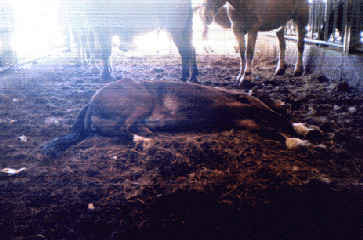
(b) All seriously crippled animals and animals commonly termed ``downers,'' shall be identified as U.S. Suspects and disposed of as provided in Sec. 311.1 of this subchapter unless they are required to be classed as condemned under Sec. 309.3.
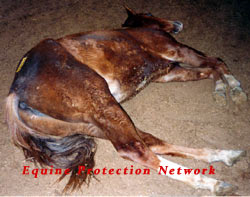
PART 309--ANTE-MORTEM INSPECTION--Table of Contents
Sec. 309.3 Dead, dying, disabled, or diseased and similar livestock.
(a) Livestock found to be dead or in a dying condition on the premises of an official establishment shall be identified as U.S. Condemned and disposed of in accordance with Sec. 309.13.
(b) Livestock plainly showing on ante-mortem inspection any disease or condition that, under part 311 of this subchapter, would cause condemnation of their carcasses on post-mortem inspection shall be identified as U.S. Condemned and disposed of in accordance with Sec. 309.13.
(c) Any swine having a temperature of 106 deg.F. or higher and any cattle, sheep, goats, horses, mules, or other equines having a temperature of 105 deg.F. or higher shall be identified as U.S. Condemned. In case of doubt as to the cause of the high temperature, or when for other reasons a Program employee deems such action warranted, any such livestock may be held for a reasonable time under the supervision of a Program employee for further observation and taking of temperature before final disposition of such livestock is determined. Any livestock so held shall be reinspected on the day it is slaughtered. If, upon such reinspection, or when not held for further observation and taking of temperature, then on the original inspection, the animal has a temperature of 106 deg.F. or higher in the case of swine, or 105 deg.F. or higher in the case of other livestock, it shall be condemned and disposed of in accordance with Sec. 309.13.
(d) Any livestock found in a comatose or semicomatose condition or affected with any condition not otherwise covered in this part, which would preclude release of the animal for slaughter for human food, shall be identified ``U.S. Condemned'' and disposed of in accordance with Sec. 309.13, except that such animal may be set apart and held for further observation or treatment under supervision of a Program employee or other official designated by the area supervisor and for final disposition in accordance with this part.
PART 309--ANTE-MORTEM INSPECTION--Table of Contents
Sec. 309.4 Livestock showing symptoms of certain metabolic, toxic, nervous, or circulatory disturbances, nutritional imbalances, or infectious or parasitic diseases.
 (a) All livestock showing, on ante-mortem inspection, symptoms of anaplasmosis, ketosis, leptospirosis, listeriosis, parturient paresis, pseudorabies, rabies, scrapie, tetanus, grass tetany, transport tetany, strangles, purpura hemorrhagica, azoturia, infectious equine encephalomyelitis, toxic encephalomyelitis (forage poisoning), dourine, acute influenza, generalized osteoporosis, glanders (farcy), acute inflammatory lameness or extensive fistula shall be identified as U.S. Condemned and disposed of in accordance with Sec. 309.13.
(a) All livestock showing, on ante-mortem inspection, symptoms of anaplasmosis, ketosis, leptospirosis, listeriosis, parturient paresis, pseudorabies, rabies, scrapie, tetanus, grass tetany, transport tetany, strangles, purpura hemorrhagica, azoturia, infectious equine encephalomyelitis, toxic encephalomyelitis (forage poisoning), dourine, acute influenza, generalized osteoporosis, glanders (farcy), acute inflammatory lameness or extensive fistula shall be identified as U.S. Condemned and disposed of in accordance with Sec. 309.13.
(b) If any equine is suspected on ante-mortem inspection of being infected with glanders or dourine, the nearest Veterinary Services unit of the Animal and Plant Health Inspection Service shall be so informed by a Program employee. Tests shall be performed by [[Page 110]] said unit to determine whether the animal is, in fact, infected with such disease. If it is found on such tests to be infected, the animal shall be disposed of in accordance with paragraph (a) of this section. Otherwise, the animal shall be identified as a U.S. Suspect and disposed of as provided in Sec. 311.10 of this subchapter.
PART 309--ANTE-MORTEM INSPECTION--Table of Contents
Sec. 309.10 Onset of parturition.
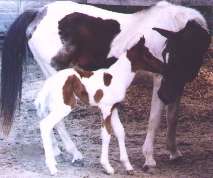
Any livestock showing signs of the onset of parturition shall be withheld from slaughter until after parturition and passage of the placenta. Slaughter or other disposition may then be permitted if the animal is otherwise acceptable.
Miracle gave birth 6 days after being rescued from the auction in New Holland. TEAR outbid the 'killer buyers' to save this mare & her unborn foal.
CHAPTER III--FOOD SAFETY AND INSPECTION SERVICE, DEPARTMENT OF AGRICULTURE
PART 311--DISPOSAL OF DISEASED OR OTHERWISE ADULTERATED CARCASSES AND PARTS--Table of Contents
Sec. 311.26 Emaciation.
Carcasses of livestock too emaciated to produce wholesome meat, and carcasses which show a serous infiltration of muscle tissues, or a serous or mucoid degeneration of the fatty tissue, shall be condemned. A gelatinous change of the fat of the heart and kidneys of well-nourished carcasses and mere leanness shall not be classed as emaciation.
Save America's Horses!
|
|||||||
